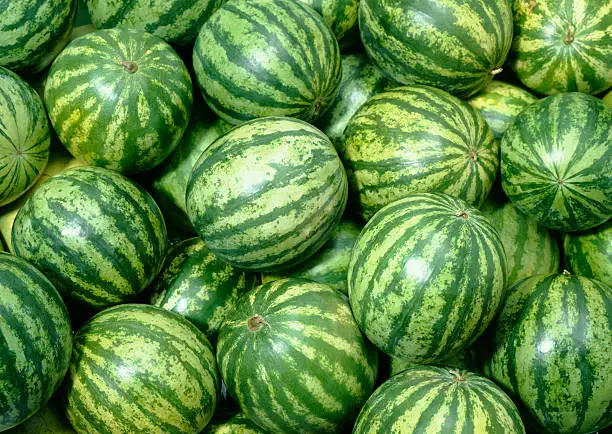
Learning how to pick a watermelon doesn’t have to feel like going on a blind date anymore! With these proven watermelon selection tips, you’ll choose the juiciest, sweetest melon every time you visit the market. Whether you’re planning to pick a watermelon salad, grill it for a healthy dessert, or simply enjoy it on a hot summer day, selecting the right watermelon is the key to maximum flavor and satisfaction. Watermelon is the best fruit for constipation if we take it before breakfast.
Have you ever been to the store dreaming of making a perfect watermelon salad, only to realize you had no idea how to tell if a watermelon is ripe? You’re definitely not alone! Picking the best watermelon requires knowing what signs of ripe watermelon to look for, and once you master these watermelon-buying tips, you’ll never second-guess your selection again.
Understanding watermelon ripeness and sweetness indicators helps you become a better fruit selector. Several factors determine how sweet and juicy your melon will be, including growing conditions, pollination, and most importantly, proper ripening time. We must have deep knowledge before picking a watermelon because a sweet watermelon should have specific characteristics that we can judge through careful testing.
The best time to buy watermelon is during peak watermelon season, typically from late spring through early fall, when melons have had optimal growing conditions. During this time, you’ll find the most flavorful options at markets and stores.

To Pick a watermelon, look for one that appears symmetrical. Whether oval or round, a ripe watermelon should have a consistent, even shape without irregular bumps or odd proportions. This symmetrical watermelon indicates proper, even growth and development.
A quality watermelon should feel surprisingly heavy for its size. This weight indicates high water content, which translates to a juicy watermelon selection. Avoid melons that appear large but feel surprisingly light, as these often lack the moisture that makes watermelons so refreshing.
Pick a Watermelon, the most reliable watermelon sweetness indicator. This creamy yellow spot shows where the watermelon rested on the ground while ripening. A ripe watermelon will have a large, dark yellow or creamy yellow field spot. If you see a white or pale field spot, the melon likely needs more time to ripen and won’t be as sweet.
A great sign to pick a watermelon is that a ripe watermelon has dull, matte skin rather than shiny, glossy skin. The dull appearance indicates the melon has reached maturity. Shiny skin typically means the watermelon was picked too early and hasn’t developed its full sweetness potential.
Look closely at the webbing pattern (those dark, web-like markings on the skin). Extensive webbing indicates good pollination and often correlates with a sweeter melon. These “sugar spots” are actually a positive sign that you’re looking at a well-developed, sweet, and juicy melon.
Pick a watermelon and perform the classic tap test by holding the watermelon close to your ear and knocking on it. A ripe watermelon produces a deep, hollow sound that resonates like a tenor. An unripe watermelon will produce a higher-pitched, less resonant sound. This tap test sound is one of the most traditional methods for determining ripeness.
When you pick a watermelon at the market, follow these watermelon picking tips for beginners:
Step 1: Survey your options and identify several symmetrical candidates.
Step 2: Lift each potential watermelon to assess if it’s heavy for its size.
Step 3: Examine the field spot – look for that creamy yellow “bald spot.”
Step 4: Check the webbing pattern for extensive sugar spots.
Step 5: Confirm the skin appears dull rather than shiny.
Step 6: Perform the tap test on your final candidates.
Step 7: Choose the melon that checks all these boxes
Understanding the difference between ripe vs unripe watermelon helps you avoid disappointment. A ripe watermelon will have a prominent yellow field spot, dull skin, extensive webbing, and produce a deep sound when tapped. An unripe watermelon typically shows a white or very pale field spot, shiny skin, minimal webbing, and produces a higher-pitched sound when knocked.
When selecting fruit for salads, choose a melon that’s perfectly ripe but still firm. The flesh should be crisp enough to hold its shape when cubed, making it ideal for refreshing salads with lime and herbs.
For grilling, select a watermelon that’s ripe but not overripe. The natural sugars will caramelize beautifully on the grill, creating an incredible healthy dessert. Try grilled watermelon with lime and chili for an amazing flavor combination.
Choose an extra-sweet watermelon for this combination. The natural sweetness pairs perfectly with tangy lime juice and a dash of Aleppo pepper watermelon twist, creating a refreshing treat that’s perfect for hot summer days.
Choosing based on size alone: Bigger isn’t always better. Focus on the signs of ripeness rather than just selecting the largest melon.
Ignoring the field spot: This is your most reliable indicator of ripeness and sweetness.
Picking shiny melons: Shiny skin indicates the melon was likely picked too early.
Not performing the tap test: This traditional method really works for identifying ripe melons.
Choosing irregular shapes: Symmetry indicates even, proper development.
Keep whole watermelons at room temperature for up to a week, or refrigerate for up to two weeks. The cool temperature will slow down any further ripening.
Once cut, store watermelon pieces in airtight containers in the refrigerator. Properly stored cut watermelon will stay fresh for 3-5 days. For best results, place cut pieces in containers lined with paper towels to absorb excess moisture.
The best indicators are the field spot color (should be creamy yellow), extensive webbing patterns, and the deep sound from the tap test. These external signs reliably predict internal sweetness.
A sweet, ripe watermelon produces a deep, resonant sound when tapped – similar to a tenor’s voice. The sound should be hollow and low-pitched rather than high or flat.
Farmers look for the same signs we’ve discussed: field spot color, webbing patterns, and the sound test. They also check the tendril nearest to where the watermelon attaches to the vine – when it turns brown and dry, the melon is typically ready.
White flesh usually indicates the watermelon was picked too early or didn’t receive adequate sunlight during growing. Always check for proper field spot coloration to avoid this issue.
An overripe watermelon may have an overly large, very dark field spot, extremely dull or matte skin, and may feel soft when pressed. The tap test will produce a very deep, almost muffled sound.
Look for a field spot that’s creamy yellow to dark yellow in color and relatively large (about the size of your palm). This indicates the melon spent adequate time ripening on the vine.
Once you’ve mastered these selection techniques, try these refreshing preparation ideas:
Classic Preparation: Cut into wedges and serve with lime juice and a dash of Aleppo pepper for a traditional Middle Eastern twist.
Watermelon Sangria: Blend cubes of your perfectly selected melon with white wine and fresh herbs for a refreshing summer cocktail.
Grilled Watermelon: Slice thick rounds and grill briefly for a caramelized, smoky flavor that makes an unexpected but delicious healthy dessert.
Fresh Salads: Combine cubed watermelon with feta cheese, mint, and a light vinaigrette for a perfect summer side dish.
Now that you know how to pick a watermelon using these time-tested techniques, you’ll never have to worry about bringing home a disappointing melon again. Remember to look for that telltale creamy yellow field spot, choose melons that are heavy for their size, listen for the deep tenor sound, and examine the webbing pattern. With practice, these watermelon picking tips for beginners will become second nature, and you’ll be selecting the sweetest, juiciest melons with confidence every time you visit the market.
The next time watermelon season arrives, you’ll be armed with the knowledge to choose perfect melons that will make your watermelon salads, grilled desserts, and refreshing snacks delicious. Happy melon hunting!
For the latest blogs, you must visit us;
No comments yet. Be the first to comment!
You must be logged in to post a comment.

Recent Comments